10 Best High-Fiber Foods for Weight Loss
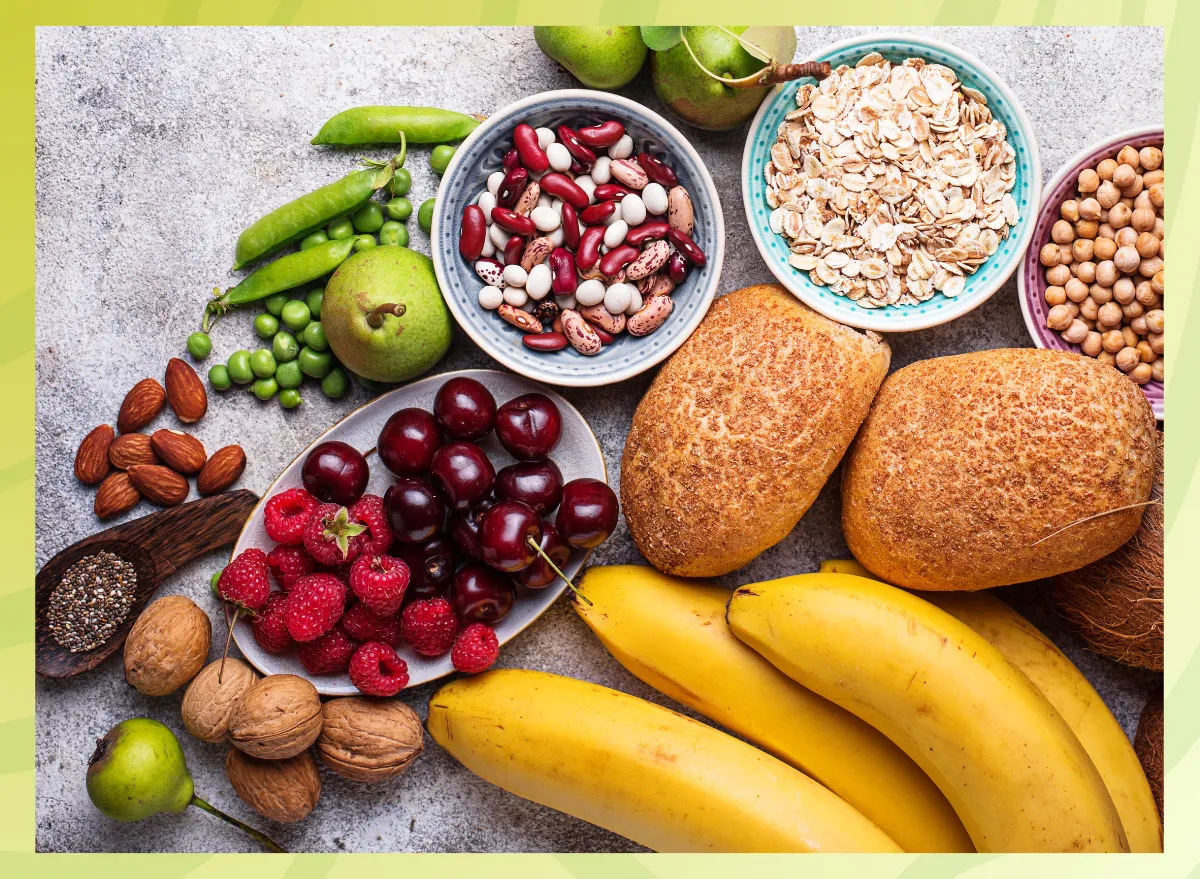
If you want to lower that number on the scale, one simple yet effective strategy is incorporating more high-fiber foods into your diet. Fiber is one of the best nutrients when it comes to weight loss. It aids digestion and increases satiety, helping prevent overeating and keeping you full and satisfied, thus supporting weight loss.
Fiber is a type of carbohydrate found only in plants. While your body can't digest fiber, this essential nutrient acts like a natural cleanser for your digestive system. Fiber comes in two main types: soluble and insoluble. Soluble fiber dissolves in water, forming a gel-like substance in the digestive tract and has also been found to act as a food source for the healthy bacteria that live in your gut microbiome. Conversely, insoluble fiber doesn't dissolve in water and adds bulk to your stool, which can help keep you regular. Both types benefit weight loss as they help regulate blood sugar levels, improve digestion, and increase satiety.
Additionally, fiber-rich foods often require more chewing, which can help you eat slower and give your body more time to register fullness. High-fiber foods like fruits, vegetables, and whole grains also tend to be lower in calories, making them an excellent weight-loss choice.
We spoke with Destini Moody, RDN, CSSD, LD, a registered dietitian and sports dietitian with Garage Gym Reviews, who reveals the top 10 high-fiber foods that are scientifically backed to help you on your weight loss journey. Read on, and for more, don't miss 25 Best Portion-Controlled Grocery Snacks for Weight Loss.
Chia Seeds
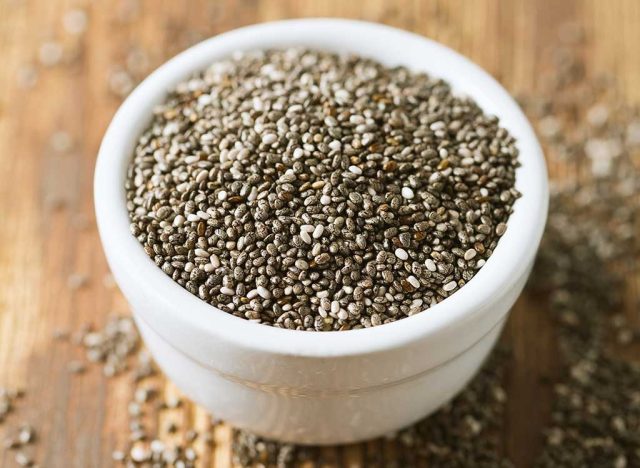
Fiber per 1-ounce serving: 10 grams
They may be tiny, but chia seeds are nutritional powerhouses. Packed with fiber, protein, and plant-based omega-3 fatty acids, they can absorb water and expand in your stomach, helping you feel full and satisfied. However, chia seeds also provide 138 calories per ounce, so Moody recommends being mindful of your intake to avoid overconsuming calories. "Chia seeds are calorie-dense, so watch your portions," says Moody. Keep your portions to 1 or 2 tablespoons, which delivers 51 or 102 calories, respectfully.
Lentils
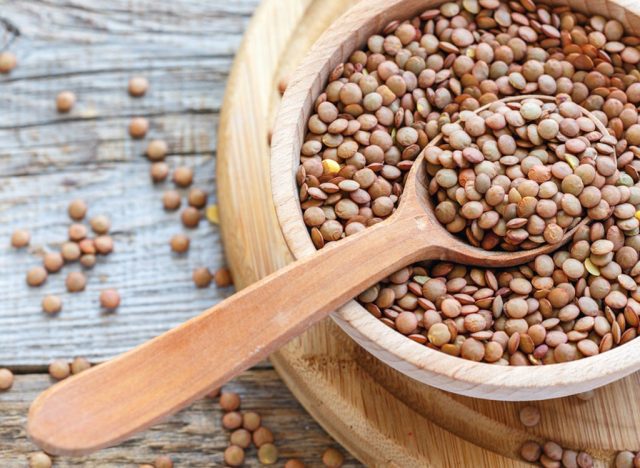
Fiber per 1 cup serving (cooked): 16 grams
Lentils are a fantastic weight loss food because they're packed with both soluble and insoluble fiber. At 18 grams per cup, they're also rich in protein, which can help you feel full and satisfied. "Legumes are known for their high fiber content, and lentils are among the most fiber-rich foods in the pulses family," says Moody. "They're a versatile food that can fit almost anywhere in a weight loss diet, with the ability to add them to nearly any savory dish, from soups to salads to sides."
Raspberries
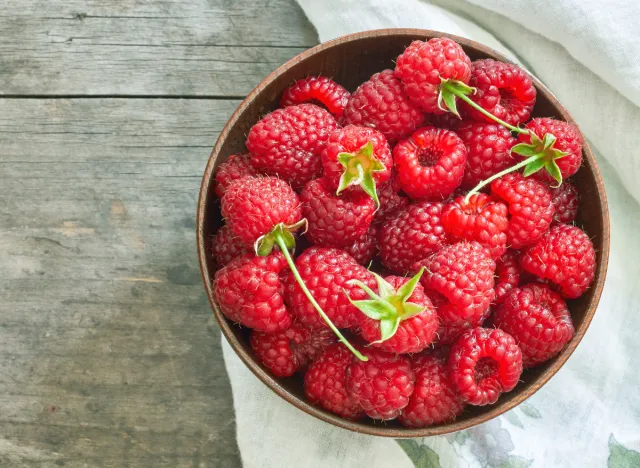
Fiber per 1 cup serving: 8 grams
While berries in general are excellent sources of fiber, raspberries take the crown as the berry with the most fiber, tied with blackberries. "The antioxidant levels in berries are among the highest of any food," Moody explains. "Berries are a great snack to have while trying to lose weight, and you can eat a large portion of them to satisfy a craving for dessert, with none of the refined sugar and lack of fiber that comes with most sweets."
Collard Greens
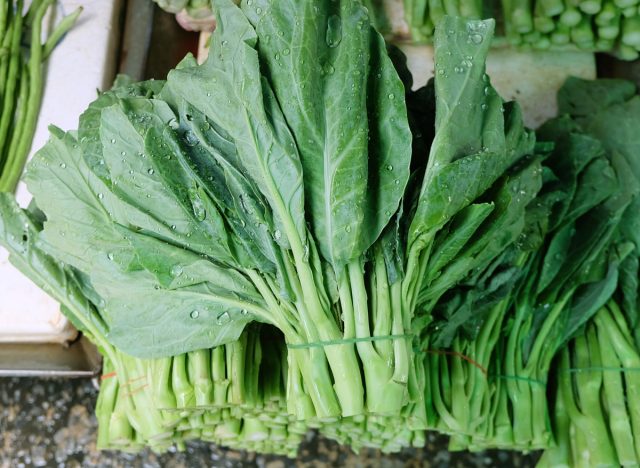
Fiber per 1 cup serving: 8 grams
These leafy greens are both delicious and nutritious. Beyond their high fiber content, collard greens contain essential vitamins and minerals that help support healthy weight loss.
"Collard greens are rich in antioxidants and vitamins K, C, and A. One cup of cooked collards has only about 65 calories, making them perfect for weight loss. Enjoy them raw as a base for a salad or cook them up in scrambled eggs, stir-fries, or casseroles," says Moody.
Artichokes
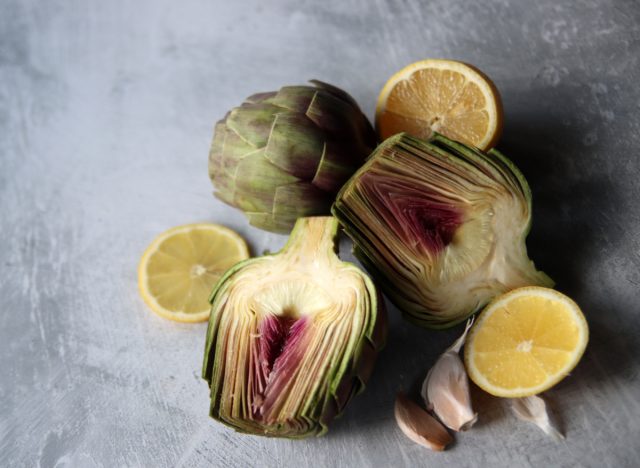
Fiber per 1 medium artichoke serving: 7 grams
Artichokes are a low-calorie, high-fiber vegetable that studies have found can help regulate blood sugar. "Artichokes are somewhat of a forgotten veggie, more often associated with creamy spinach dips," says Moody. "However, artichokes are low in calories and are a great source of vitamin C and folate. Their high fiber content comes from a fiber type called inulin, an effective prebiotic that can help promote healthy gut bacteria."
Sweet Potato with Skin
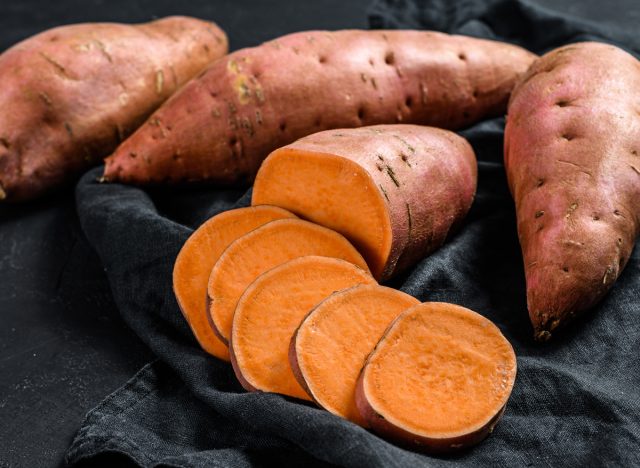
Fiber per 1 cup serving: 7 grams
Next time you bake sweet potatoes or make homemade fries, be sure to keep the skin on. A 2022 study found that the fibers in sweet potato peels can promote gut health by boosting short-chain fatty acid production. "If you're looking to add more fiber to your diet, don't peel your potatoes," Moody advises. "The peel contains half the potato's fiber and can add some nice texture to dishes."
Pears
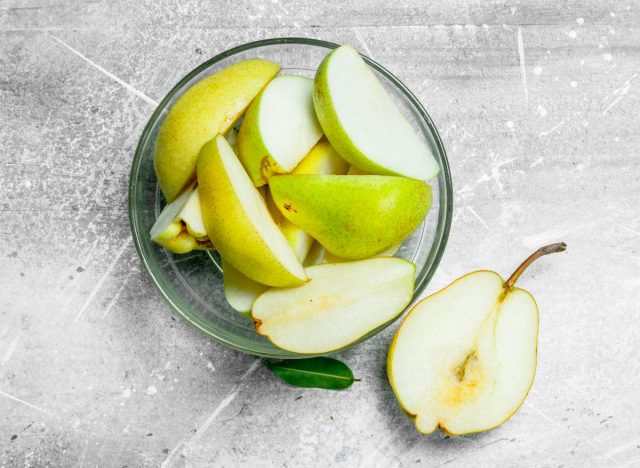
Fiber per 1 medium pear serving: 6 grams
Pears are a juicy, sweet fruit that Moody says contains soluble and insoluble fiber for weight loss. She adds, "Pears are high in a fiber called pectin, which research suggests can improve gut health, boost immune function, and prevent constipation. One medium pear contains only 100 calories, making them a great weight loss snack between meals."
Quinoa
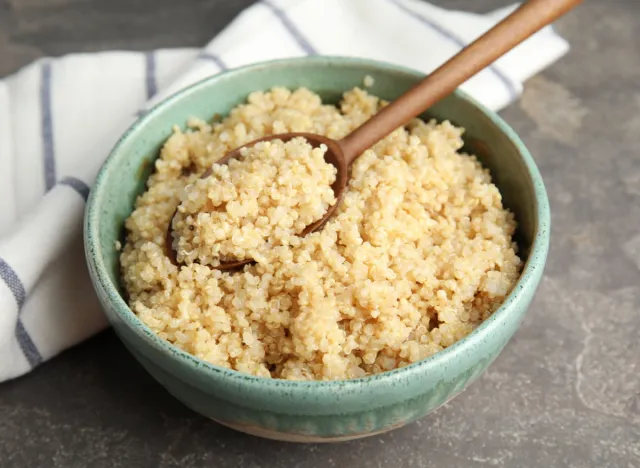
Fiber per 1 cup serving: 5 grams
Besides delivering a healthy dose of fiber per serving, quinoa is also a complete protein source, meaning it contains all nine essential amino acids your body cannot produce on its own. Quinoa's high protein content can also help keep you satiated between meals to reduce snacking. "Fiber doesn't just have to come from fruits and vegetables; it can also come from our beloved carbs, too," says Moody. Quinoa is a wonderful example of a whole grain high in fiber.
Air-Popped Popcorn
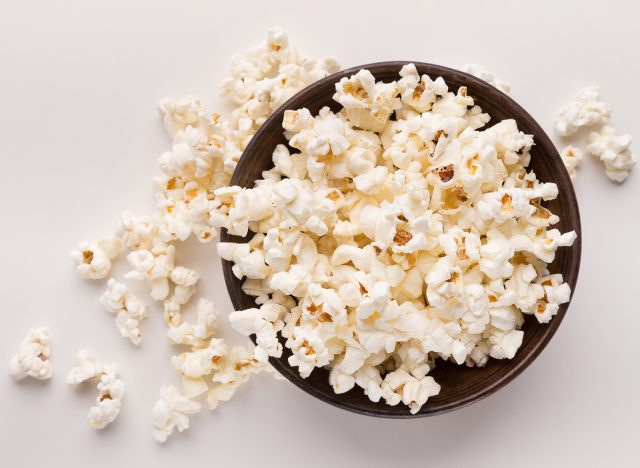
Fiber per 3-cup serving: 4 grams
When made without added butter or oil, air-popped popcorn is a high-fiber, low-calorie snack. Research suggests eating whole-grain popcorn as an alternative to traditional snacks like chips or crackers to support healthy weight management. Moody says, "Popcorn is arguably one of the best snacks for weight loss due to the amount of volume it takes up in the stomach for a relatively low number of calories. Plus, it's a fun and satisfying snack to reach for when late-night cravings strike."
Brussels Sprouts
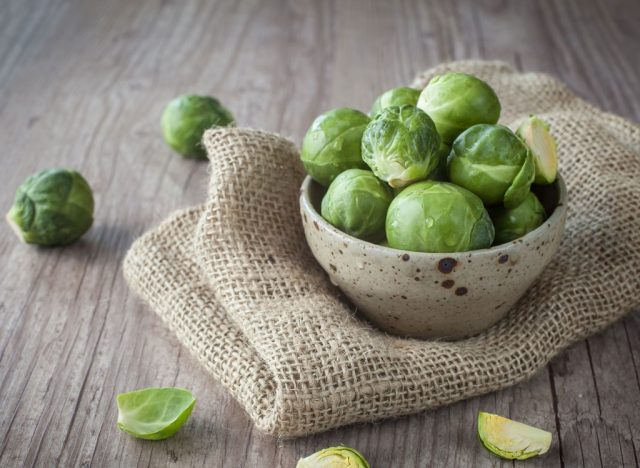
Fiber per 1 cup serving: 3 grams
Brussels sprouts are a cruciferous vegetable rich in fiber and a health-promoting compound called sulforaphane. A 2022 animal study found that sulforaphane can reduce obesity and help moderate food intake. Plus, they're delicious when cooked just right. Moody says, "Brussels sprouts are irresistible when roasted and incredibly low in calories."
- Source: Ioniță-Mîndrican, C. B., Ziani, K., Mititelu, M., Oprea, E., Neacșu, S. M., Moroșan, E., Dumitrescu, D. E., Roșca, A. C., Drăgănescu, D., & Negrei, C. (2022). Therapeutic Benefits and Dietary Restrictions of Fiber Intake: A State of the Art Review. Nutrients, 14(13), 2641. https://doi.org/10.3390/nu14132641
- Source: Wu, S., Jia, W., He, H., Yin, J., Xu, H., He, C., Zhang, Q., Peng, Y., & Cheng, R. (2023). A New Dietary Fiber Can Enhance Satiety and Reduce Postprandial Blood Glucose in Healthy Adults: A Randomized Cross-Over Trial. Nutrients, 15(21), 4569. https://doi.org/10.3390/nu15214569
- Source: Ioniță-Mîndrican, C. B., Ziani, K., Mititelu, M., Oprea, E., Neacșu, S. M., Moroșan, E., Dumitrescu, D. E., Roșca, A. C., Drăgănescu, D., & Negrei, C. (2022). Therapeutic Benefits and Dietary Restrictions of Fiber Intake: A State of the Art Review. Nutrients, 14(13), 2641. https://doi.org/10.3390/nu14132641
- Source: Guan, Z. W., Yu, E. Z., & Feng, Q. (2021). Soluble Dietary Fiber, One of the Most Important Nutrients for the Gut Microbiota. Molecules (Basel, Switzerland), 26(22), 6802. https://doi.org/10.3390/molecules26226802
- Source: Health benefits of dietary fibers vary. (2022, June 21). National Institutes of Health (NIH). https://www.nih.gov/news-events/nih-research-matters/health-benefits-dietary-fibers-vary
- Source: Khalid, W., Arshad, M. S., Aziz, A., Rahim, M. A., Qaisrani, T. B., Afzal, F., Ali, A., Ranjha, M. M. A. N., Khalid, M. Z., & Anjum, F. M. (2022). Chia seeds (Salvia hispanica L.): A therapeutic weapon in metabolic disorders. Food science & nutrition, 11(1), 3–16. https://doi.org/10.1002/fsn3.3035
- Source: Ganesan, K., & Xu, B. (2017). Polyphenol-Rich Lentils and Their Health Promoting Effects. International journal of molecular sciences, 18(11), 2390. https://doi.org/10.3390/ijms18112390
- Source: Rondanelli, M., Riva, A., Petrangolini, G., Allegrini, P., Bernardinelli, L., Fazia, T., Peroni, G., Gasparri, C., Nichetti, M., Faliva, M. A., Naso, M., & Perna, S. (2020). The Metabolic Effects of Cynara Supplementation in Overweight and Obese Class I Subjects with Newly Detected Impaired Fasting Glycemia: A Double-Blind, Placebo-Controlled, Randomized Clinical Trial. Nutrients, 12(11), 3298. https://doi.org/10.3390/nu12113298
- Source: Tawfick, M. M., Xie, H., Zhao, C., Shao, P., & Farag, M. A. (2022). Inulin fructans in diet: Role in gut homeostasis, immunity, health outcomes and potential therapeutics. International journal of biological macromolecules, 208, 948–961. https://doi.org/10.1016/j.ijbiomac.2022.03.218
- Source: Cao, Y., Tian, B., Zhang, Z., Yang, K., Cai, M., Hu, W., Guo, Y., Xia, Q., & Wu, W. (2022). Positive effects of dietary fiber from sweet potato [Ipomoea batatas (L.) Lam.] peels by different extraction methods on human fecal microbiota in vitro fermentation. Frontiers in nutrition, 9, 986667. https://doi.org/10.3389/fnut.2022.986667
- Source: Pascale, N., Gu, F., Larsen, N., Jespersen, L., & Respondek, F. (2022). The Potential of Pectins to Modulate the Human Gut Microbiota Evaluated by In Vitro Fermentation: A Systematic Review. Nutrients, 14(17), 3629. https://doi.org/10.3390/nu14173629
- Source: Quinoa. (2021, July 6). The Nutrition Source. https://www.hsph.harvard.edu/nutritionsource/food-features/quinoa/
- Source: Coco, M. G., Jr, & Vinson, J. A. (2019). Analysis of Popcorn (Zea mays L. var. everta) for Antioxidant Capacity and Total Phenolic Content. Antioxidants (Basel, Switzerland), 8(1), 22. https://doi.org/10.3390/antiox8010022
- Source: Kaiser, A. E., Baniasadi, M., Giansiracusa, D., Giansiracusa, M., Garcia, M., Fryda, Z., Wong, T. L., & Bishayee, A. (2021). Sulforaphane: A Broccoli Bioactive Phytocompound with Cancer Preventive Potential. Cancers, 13(19), 4796. https://doi.org/10.3390/cancers13194796
- Source: Çakır, I., Lining Pan, P., Hadley, C. K., El-Gamal, A., Fadel, A., Elsayegh, D., Mohamed, O., Rizk, N. M., & Ghamari-Langroudi, M. (2022). Sulforaphane reduces obesity by reversing leptin resistance. eLife, 11, e67368. https://doi.org/10.7554/eLife.67368









